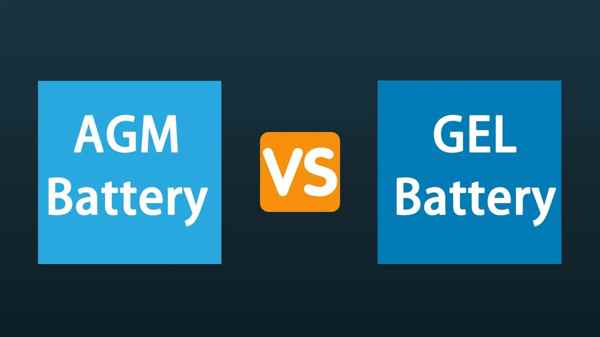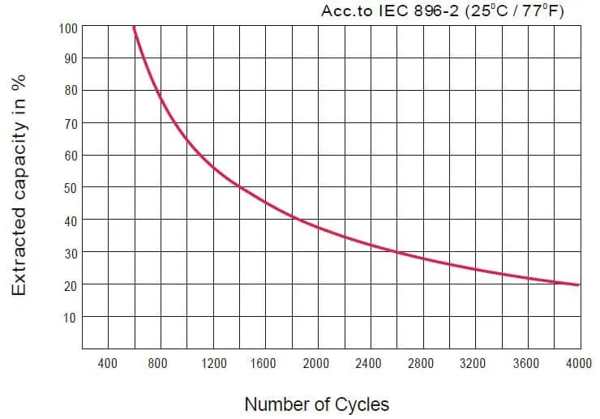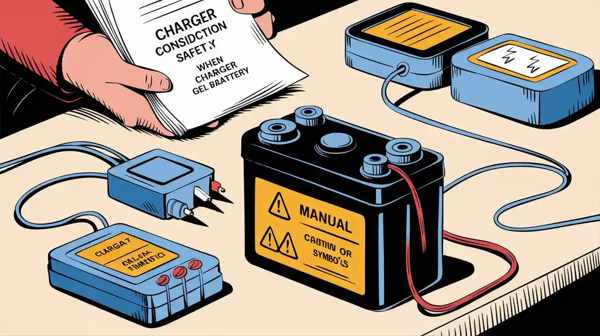Che è meglio, una batteria AGM o gel?
Quando stai cercando un affidabile, Batteria senza manutenzione per il tuo sistema solare, barca, o potere di backup, Incontrerai rapidamente due opzioni popolari: AGM e gel. Sono entrambi tipi di batterie a acido piombo sigillate, Ma usano diverse tecnologie internamente, Il che li rende più adatti per lavori diversi. COSÌ, Quale è veramente meglio?
Né AGM né Gel sono universalmente "migliori"; La scelta migliore dipende dalla tua applicazione specifica. In breve, AGM (Tappetino di vetro assorbente) Le batterie sono generalmente migliori per le applicazioni che richiedono una potenza elevata (Come l'avvio di un motore) e le batterie di ricarica più veloci spesso eccellono in lente, Applicazioni a scarico in profondità e può essere più tollerante a temperature ambiente molto elevate.

A Gycx Solar, Lavoriamo con una vasta gamma di tecnologie a batteria, E la nostra competenza sta nell'abbinare la batteria giusta al lavoro giusto. Abbattiamo le differenze tra AGM e Gel per aiutarti a prendere una decisione informata.
Sono batterie AGM Lead-acid o gel?
Con tutti gli acronimi, È facile confondersi. Sono tecnologie concorrenti AGM e Gel, o sono correlati? Chiariamo l'albero genealogico della batteria.
Le batterie AGM sono un tipo di Acido di piombo batteria, Ma lo sono non Batterie in gel. Pensa al "acido di piombo" Come il nome di famiglia principale. Sotto quella famiglia, Hai due rami principali: tradizionale "allagato" batterie (che richiedono manutenzione) e "acido di piombo sigillato" o batterie VRLA (che sono esenti da manutenzione). Sia AGM che gel sono due diversi tipi di batterie VRLA sigillate. La differenza chiave tra loro è il modo in cui immobilizzano l'elettrolita acido all'interno.

Immergersi più in profondità: Una rapida guida alla terminologia
- Batteria al piombo-acido: La categoria complessiva della batteria che utilizza piastre di piombo e un elettrolita di acido solforico.
- Acido di piombo allagato (Fla): Il tradizionale, "cellula bagnata" tipo. Le piastre di piombo sono immerse in acido liquido, E richiede un rastrellamento regolare con acqua distillata.
- Acido di piombo sigillato (VRLA-Acido di piombo regolato dalla valvola): La categoria senza manutenzione. La batteria è sigillata, e i gas interni vengono ricombinati.
- AGM (Tappetino di vetro assorbente): L'acido viene assorbito e tenuto in posizione da tappeti in fibra di vetro molto fine inseriti tra le piastre di piombo.
- Gel: L'acido viene miscelato con fumi di silice per creare uno spesso, gel viscoso che non scorre.
COSÌ, mentre entrambi sono sigillati e esenti da manutenzione, Il metodo che usano per contenere l'acido fornisce loro diverse caratteristiche di prestazione.
Come capire se la batteria è AGM o gel?
Hai una batteria con acido piombo sigillato, Ma non sei sicuro che sia un AGM o un gel. Conoscere la differenza è fondamentale perché richiedono diversi profili di ricarica. Come puoi identificare quale tipo hai?
Il modo più affidabile per dire se una batteria è AGM o gel Leggi l'etichetta sulla custodia della batteria. La maggior parte dei produttori stamperà chiaramente "AGM," "Tappetino in vetro assorbente," "Gel," o "Gel Cell" Sull'adesivo. Se l'etichetta è usurata o poco chiara, Il tuo prossimo miglior passo è quello di Cerca il numero di modello online Sul sito web del produttore. L'applicazione prevista del prodotto può anche essere un indizio.

Immergersi più in profondità: La tua lista di controllo dell'identificazione
Ecco i passaggi per identificare il tipo di batteria:
- Leggi attentamente l'etichetta: Questo è il metodo più diretto. Cerca il nome della tecnologia. A volte potrebbe solo dire "vrla" o "acido di piombo sigillato," In tal caso potrebbe essere necessario scavare più a fondo.
- Cerca il numero del modello: Ogni batteria ha un numero di modello (PER ESEMPIO., "8a31dt" o "GPL-31T"). Una rapida ricerca su Internet di quel numero di modello ti porterà quasi sempre a una pagina del prodotto o alla scheda tecnica che specifica la chimica.
- Considera l'applicazione originale:
- Batterie AGM sono eccellenti nel fornire una corrente alta, Quindi sono molto comuni nei veicoli ad alte prestazioni con tecnologia start-stop, Auto con potenti sistemi audio, e per l'avvio del motore marino o camper.
- Batterie in gel Excel a Slow, costante, scarichi profondi. Si trovano spesso negli scooter di mobilità elettrica, sedia a rotelle alimentate, e alcune applicazioni solari di telecomunicazioni o off-grid.
- Perché è fondamentale sapere: È necessario conoscere il tipo per selezionare il profilo di ricarica corretto sul controller di carica solare o solare. Utilizzando un'impostazione AGM su una batteria in gel (o viceversa) può portare a sottocarre o sovraccarico, Entrambi abbreviano la durata della batteria.
Qual è la durata di una batteria in gel?
Quando investi in un Batteria in gel1, vuoi sapere quanti anni di servizio2 puoi aspettarti. Con la cura adeguata e le giuste condizioni, Possono essere artisti durevoli, Ma la loro vita è finita.
Una batteria in gel di ciclo profondo di qualità ha in genere un file Vita del calendario di 5 A 10 anni. In termini di utilizzo, Può consegnare ovunque 500 a finire 1,000 Cicli di scarica di carica. Questa durata della vita non è garantita ed è fortemente dipendente da diversi fattori critici, in particolare Carica corretta, temperatura operativa, e quanto profondamente viene dimesso su base regolare.

Immergersi più in profondità: Fattori che determinano la longevità
La durata di servizio effettiva che ottieni dalla batteria del gel sarà determinata da queste variabili chiave:
- Metodo di ricarica: Come discuteremo dopo, L'uso del profilo di ricarica specifico per gel corretto è il singolo fattore più importante. Il sovraccarico o la sottocargo costante accorciano drasticamente la durata della batteria.
- temperatura di esercizio: Il calore è il nemico di tutte le batterie al piombo acido. La temperatura operativa ideale è di circa 25 ° C (77° f). In un clima costantemente caldo come quello di Bangkok, Una batteria tenuta in uno spazio scarsamente ventilato può vedere la sua durata di servizio tagliata a metà.
- Profondità di scarica (Dipartimento della Difesa): Questo si riferisce a quanta parte della capacità della batteria usi in ogni ciclo. Una batteria a cui è stata scaricata solo 30% della sua capacità durerà per molti più cicli di quello che viene costantemente dimesso 80%.
- Come si confronta:
- vs. AGM: La durata della vita delle batterie AGM e gel è spesso comparabile quando entrambi sono trattati bene, Sebbene il gel a volte possa offrire un leggero vantaggio nella durata del ciclo per lenta, scarichi profondi, pur essendo meno tollerante all'accusa impropria.
- vs. Litio (LFP): La differenza è significativa. Una moderna batteria LFP, Quale solare Gycx consiglia spesso per il solare, offre una vita molto più lunga (10-20 anni e 3,000-6,000+ cicli), rendendolo un investimento a lungo termine superiore per applicazioni ciclistiche giornaliere.
Una batteria in gel ha bisogno di un caricabatterie speciale?
Hai scelto una batteria in gel per la sua Vantaggi senza manutenzione3. Puoi semplicemente usare qualsiasi caricabatteria standard per tenerlo ricaricato? Questo è un punto critico in cui un errore può essere molto costoso.
sì, assolutamente. Le batterie in gel richiedono un caricatore intelligente compatibile che ha uno specifico "GEL" Profilo di ricarica. L'uso di un caricabatterie standard progettato per l'auto inondata tradizionale o le batterie a ciclo profondo danneggerà quasi sicuramente una batteria in gel nel tempo. La tensione di ricarica e l'algoritmo devono essere abbinati con precisione alla chimica del gel per garantirne la salute e la longevità.

Immergersi più in profondità: Perché il caricatore giusto non è negoziabile
Ecco perché un caricabatterie compatibile con gel è essenziale:
- Impedisce la sovratensione: Le batterie in gel sono molto sensibili all'alta tensione. Un profilo di gel adeguato utilizza setpoint di tensione inferiore (In genere, superando intorno a 14.1 V - 14,4 V.). Un caricabatterie allaonda standard potrebbe spingere la tensione a 14,8 V o superiore, che "cucinerà" il gel.
- Evita l'equalizzazione distruttiva: Molti caricabatterie per le batterie allagate hanno un "equalizzazione" modalità, che è un sovraccarico controllato progettato per bilanciare le celle. Questo processo è altamente distruttivo per una batteria in gel. Fa sì che l'acqua nell'elettrolita di gel si rompa in gas che viene sfiatato dalla batteria. Dal momento che non puoi aggiungere acqua, Questo asciuga permanentemente il gel, rovinando la sua capacità.
- Carica a più stadi: Un caricatore intelligente con un profilo gel utilizza un algoritmo a più stadi (PER ESEMPIO., massa, assorbimento, galleggiante) Questo è esattamente su misura per ciò di cui ha bisogno una batteria in gel. Si carica in modo efficiente e poi scende in un "galleggiante sicuro" tensione per mantenere la batteria senza sovraccaricarla.
- Anche AGM è diverso: È importante notare che le batterie AGM hanno anche il proprio profilo di ricarica specifico, che è diverso da gel e allagata. Un buon caricatore multi-chimico avrà impostazioni separate per ciascuno.
Gycx Solar Story: "Diciamo sempre ai nostri clienti che il caricabatterie è importante tanto quanto la batteria stessa. Quando progettiamo un sistema, Che si tratti di energia solare o di backup, Garantiamo che il controller di carica solare o il caricabatterie CA siano perfettamente programmati per la tecnologia della batteria utilizzata. Questo protegge gli investimenti del cliente ed è una parte fondamentale del nostro vantaggio professionale."
COSÌ, che è meglio, AGM o gel? È un compromesso. AGM è fantastico, cavallo di battaglia versatile, Ottimo per uso sia ad alta potenza che per il ciclo profondo. Il gel è un artista specializzato in ciclo profondo che può essere più resistente in climi molto caldi ma richiede una ricarica più precisa. Per molte moderne applicazioni solari, La conversazione ora include il litio LFP, che offre una durata e prestazioni superiori.
A Gycx solare, Abbiamo le competenze per aiutarti a navigare queste scelte. Possiamo analizzare le tue esigenze per raccomandare la tecnologia della batteria, che sia AGM, Gel, o litio: questo fornirà il miglior valore e le prestazioni per la tua applicazione specifica. Contattaci oggi per una consulenza professionale!
Comprendere la durata della vita delle batterie in gel può aiutarti a prendere decisioni di investimento informate. ↩
Esplorare questo argomento fornirà approfondimenti sulla longevità e l'affidabilità delle batterie in gel. ↩
Esplorare i benefici senza manutenzione può aiutarti ad apprezzare i vantaggi della scelta delle batterie su gel rispetto agli altri. ↩
